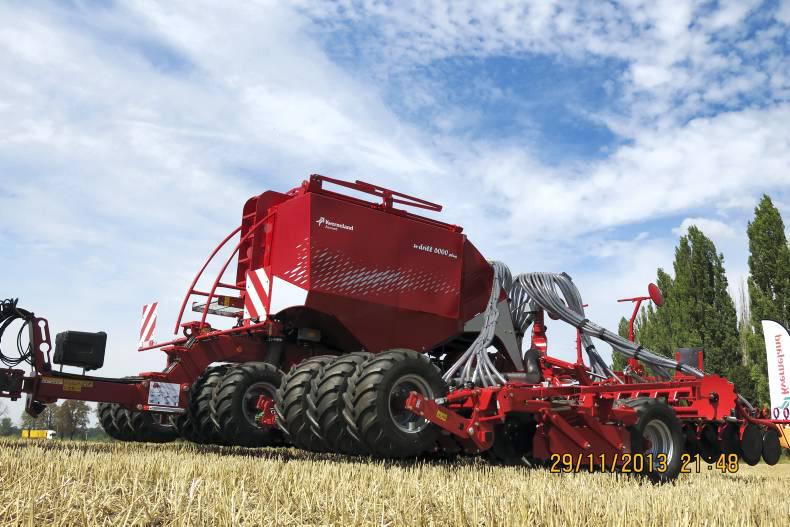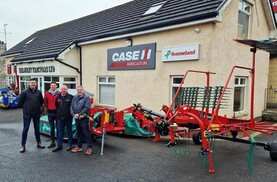The Kverneland group is now owned by Kubota, with Dai Watanabe appointed as CEO in December 2014. Dai was previously the president of Kubota Europe. Commenting on his new role, Mr Watanabe said: “My blood was Kubota orange, but it is now Kverneland red.”
The takeover has allowed the Kverneland brand access to the American hay and forage market through the existing Kubota distribution channels.
The Kverneland brand will remain in countries where distribution is already taken care of. What seems to be apparent is that the Kverneland design team have been given funding to develop new products.
There was over 30 new launches on display last week in the Czech Republic. We will feature just a few of those this week.

Picture 1
From spring 2016, a combined grain and fertiliser version of the Kverneland foldable 6m U-drill will be available. The new U-drill plus has the ability to place fertiliser within the row of the seed and beside the seed row by application with the disc harrow. The drill has separate distributor heads for grain and fertiliser.
According to Kverneland, the drill can deliver fertiliser application rates up to 400kg/ha at 15km/h.
Product specialist for Ireland John Mulhall said: “The pressurised hopper system ensures these rates are maintained consistently.”
The hydraulic fan drive is powered from the tractor’s hydraulics.
Application rates for seeds and fertiliser are controlled by two identically constructed, infinitely adjustable metering devices. Wheels for fine to big seeds and fertiliser are available.
Both metering devices are ISOBUS compatible and electrically driven, which allows fertiliser and seed rates to be adjusted independently. The new U-drill plus has a working width of 6m with a 4,200-litre hopper. The breakdown is 40% seed and 60% fertiliser.

Picture 2
The Kverneland 2500 series plough has been in development for the last five years. This new generation targets a growing segment of the market for five- to six-furrow ploughs.
The redesigned headstock allows for the plough to be folded and locked in the transport position from the tractor cab. This is achieved by adding a hydraulic ram to tilt the headstock. The toplink does not have to be removed.
The plough leg has also changed to the aero-profile design. The idea behind this concept is to limit the drag effect on the plough, with the design reducing the welding on the corners of the plough leg. According to Kverneland, the leg will be easier to pull, saving on fuel costs.
Another redesign for adjusting the skimmers is a central turn nut that adjusts each skimmer by the same amount on both sides of the plough.
The land wheel design has changed from a pendulum to a pivot system. According to Kverneland, this is much safer for the road as it is located in a more central position on the plough and tractor.
A unique rubber belt track is now a second option for this plough, instead of the conventional land wheel. The tracked option gives a greater contact area to reduce compaction.
There are also three operator control options for the plough. The basic control is a handheld switch to select the relevant functions on the plough. The medium-spec unit gives a visual display of the plough’s functions and adjustments.
On the top-of-the-range ISOBUS controlled plough, everything is controlled from the screen in the tractor cab.

Picture 3
Developed at the Kverneland group’s baler centre at Ravenna, Italy, FastBale claims to be both the world’s only non-stop fixed-chamber baler and baler-wrapper combination.
This was the first public viewing of this new concept in action. The original design came from the west of Ireland, when an Irish engineer approached the company. First impressions are that it appears to be a contender to compete with the other machines in this category.
A double-chamber system, the first chamber completes two-thirds of the bale. It then passes on to the second chamber where the bale is completed and net wrap applied.
The arrangements of the chambers mean that several rollers can be shared. Net is then applied to the completed bale, the tailgate is opened and the bale is transferred on to the wrapper.
The three stages in the sequence allow the baler to remain constantly on the move.
To make bale transfer simple and reliable, the engineers devised a wrapper frame mounted on a parallel linkage. This enables the wrapper to be lowered to meet the completed bale as it simply rolls from the main chamber.
Kverneland claims it avoids the need for a complex mechanical transfer system.
The machine is fitted with twin satellite arms. The wrapping sequence travels over and under the bale, reducing the length of the machine.
Once complete, the wrapper is lowered and the rear wrapper roller is then raised, releasing the wrapped bale on to the ground. Kverneland also says the FastBale is shorter than any other baler-wrapper combination on the market.






 This is a subscriber-only article
This is a subscriber-only article












SHARING OPTIONS: